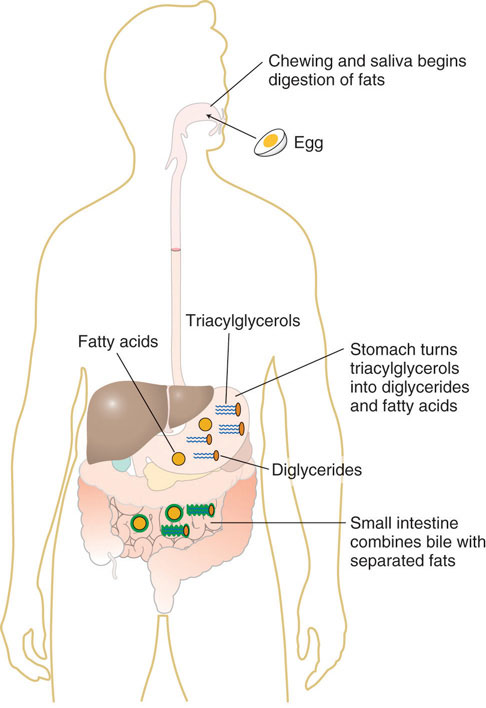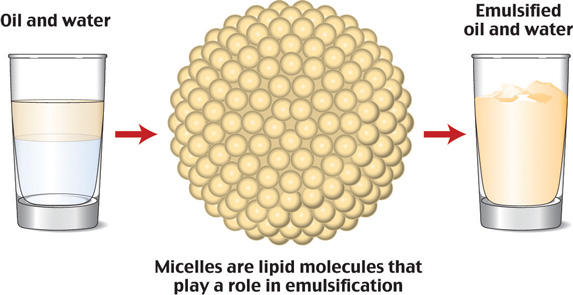6.5 – Digestion and Absorption of Lipids
Learning Objectives
- Summarize the steps in lipid digestion, absorption, and transport.
- Explain how lipids are used for energy and stored in the body.
Lipids are large molecules and generally are not water-soluble. Like carbohydrates and protein, lipids are broken into small components for absorption. Since most of our digestive enzymes are water-based, how does the body break down fat and make it available for the various functions it must perform in the human body?
From the Mouth to the Stomach
The first step in the digestion of triglycerides and phospholipids begins in the mouth as lipids encounter saliva. Next, the physical action of chewing coupled with the action of emulsifiers enables the digestive enzymes to do their tasks. The enzyme lingual lipase, along with a small amount of phospholipid as an emulsifier, initiates the process of digestion. These actions cause the fats to become more accessible to the digestive enzymes. As a result, the fats become tiny droplets and separate from the watery components.

A hard-boiled egg is eaten; chewing and saliva begin the digestion of fats. The stomach turns triacylglycerols into diglycerides and fatty acids. The small intestine combines bile with separated fats. In the stomach, gastric lipase starts to break down triglycerides into diglycerides and fatty acids. Within two to four hours after eating a meal, roughly 30 percent of the triglycerides are converted to diglycerides and fatty acids. The stomach’s churning and contractions help to disperse the fat molecules, while the diglycerides derived in this process act as further emulsifiers. However, even amid all of this activity, very little fat digestion occurs in the stomach.
Going to the Bloodstream
As the stomach contents enter the small intestine, the digestive system sets out to manage a small hurdle, namely, to combine the separated fats with its own watery fluids. The solution to this hurdle is bile. Bile contains bile salts, lecithin, and substances derived from cholesterol so it acts as an emulsifier. It attracts and holds on to fat while it is simultaneously attracted to and held on to by water. Emulsification increases the surface area of lipids over a thousand-fold, making them more accessible to the digestive enzymes.
Once the stomach contents have been emulsified, fat-breaking enzymes work on the triglycerides and diglycerides to break apart fatty acids from their glycerol foundations. As pancreatic lipase enters the small intestine, it breaks down the fats into free fatty acids and monoglycerides. Yet again, another hurdle presents itself. How will the fats pass through the watery layer of mucus that coats the absorptive lining of the digestive tract? As before, the answer is bile. Bile salts envelop the fatty acids and monoglycerides to form micelles. Micelles have a fatty acid core with a water-soluble exterior. This allows efficient transportation to the intestinal microvillus. Here, the fat components are released and move into the cells of the digestive tract lining.

A glass with oil and water in 2 separate layers is on the left. An arrow points from the glass to micelles shown as a sphere of spheres. Micelles are lipid molecules that play a role in emulsification. An arrow from the micelles points to a glass of emulsified oil and water on the right.
Just as lipids require special handling in the digestive tract to move within a water-based environment, they require similar handling to travel in the bloodstream. Inside the intestinal cells, the monoglycerides and fatty acids reassemble themselves into triglycerides. Triglycerides, cholesterol, and phospholipids form lipoproteins (lipid transport vehicles) when joined with a protein carrier. Together they form a chylomicron, which is a large lipoprotein that now enters the lymphatic system and will soon be released into the bloodstream via the jugular vein in the neck. Chylomicrons transport fats from food perfectly through the body’s water-based environment to specific destinations such as the liver and other body tissues.
Cholesterol is poorly absorbed when compared to phospholipids and triglycerides. Cholesterol absorption is aided by an increase in dietary fat components and is hindered by high fiber content. This is the reason that a high intake of fiber is recommended to decrease blood cholesterol. Foods high in fiber such as fresh fruits, vegetables, and oats can bind bile salts and cholesterol, preventing their absorption and carrying them out of the colon.
If fats are not absorbed properly as is seen in some medical conditions, a person’s stool will contain high amounts of fat. If fat malabsorption persists the condition is known as steatorrhea. Steatorrhea can result from diseases that affect absorption, such as Crohn’s disease and cystic fibrosis.
The Truth about Storing and Using Body Fat
Before the prepackaged food industry, fitness centers, and weight-loss programs, our ancestors worked hard to even locate a meal. They made plans, not for losing those last ten pounds to fit into a bathing suit for vacation, but rather for finding food. Today, this is why we can go long periods without eating, whether we are sick with a vanishing appetite, our physical activity level has increased, or there is simply no food available. Our bodies reserve fuel for a rainy day.
We learned earlier that the body transforms carbohydrates into glycogen that is in turn stored in the muscles and liver for energy. When the body reaches its capacity for glycogen storage, the excess energy from carbohydrate is returned to the liver, where it is converted into triglycerides and then stored as fat.
In a similar manner, much of the triglycerides the body receives from food is transported to fat storehouses (adipose cells) within the body if not used for producing energy. The chylomicrons are responsible for shuttling the triglycerides to various locations such as the muscles, breasts, external layers under the skin, and internal fat layers of the abdomen, thighs, and buttocks where they are stored by the body in adipose tissue for future use. How is this accomplished? Recall that chylomicrons are large lipoproteins that contain triglycerides as a fatty-acid core. Capillary walls contain an enzyme called lipoprotein-lipase that dismantles the triglycerides in the lipoproteins into fatty acids and glycerol, thus enabling these to enter into the adipose cells. Once inside the adipose cells, the fatty acids and glycerol are reassembled into triglycerides and stored for later use. Muscle cells may also take up the fatty acids and use them for muscular work and generating energy. When a person’s energy requirements exceed the amount of available fuel presented from a recent meal or extended physical activity has exhausted glycogen energy reserves, fat reserves are retrieved for energy utilization.
As the body calls for additional energy, the adipose tissue responds by breaking down its triglycerides and releasing glycerol and fatty acids directly into the blood. Albumin will carry these free fatty acids to the cells of the body. Upon receipt of these substances, the energy-hungry cells break them down further into tiny fragments. These fragments go through a series of chemical reactions that yield energy, carbon dioxide, and water.
Key Takeaways
- In the stomach fat is separated from other food substances. In the small intestines, bile emulsifies fats while enzymes digest them. The intestinal cells absorb the fats.
- Long-chain fatty acids form a large lipoprotein structure called a chylomicron that transports fats through the lymph system.
- Chylomicrons are formed in the intestinal cells and carry lipids from the digestive tract into circulation.
- Short- and medium-chain fatty acids can be absorbed directly into the bloodstream from the intestinal microvillus because they are water-soluble.
- Cholesterol absorption is hindered by foods high in fiber. The fiber in the intestinal tract can bind cholesterol and stop it from being absorbed into the body.
- When energy supplies are low the body utilizes its stored fat reserves for energy.
Discussion Starters
- Discuss why patterns of eating are more important to overall health than the quantity of fat consumed or taking dietary supplements.
- Explain the role of emulsifiers in fat digestion.
- Name the part of the digestive system where most fat digestion and absorption occurs.
- Describe the role of bile salts in the digestion of triacylglycerols and phospholipids.
- Define chylomicron.
- Explain how fiber-rich foods affect cholesterol absorption.
- Discuss the body’s processes for using energy.

